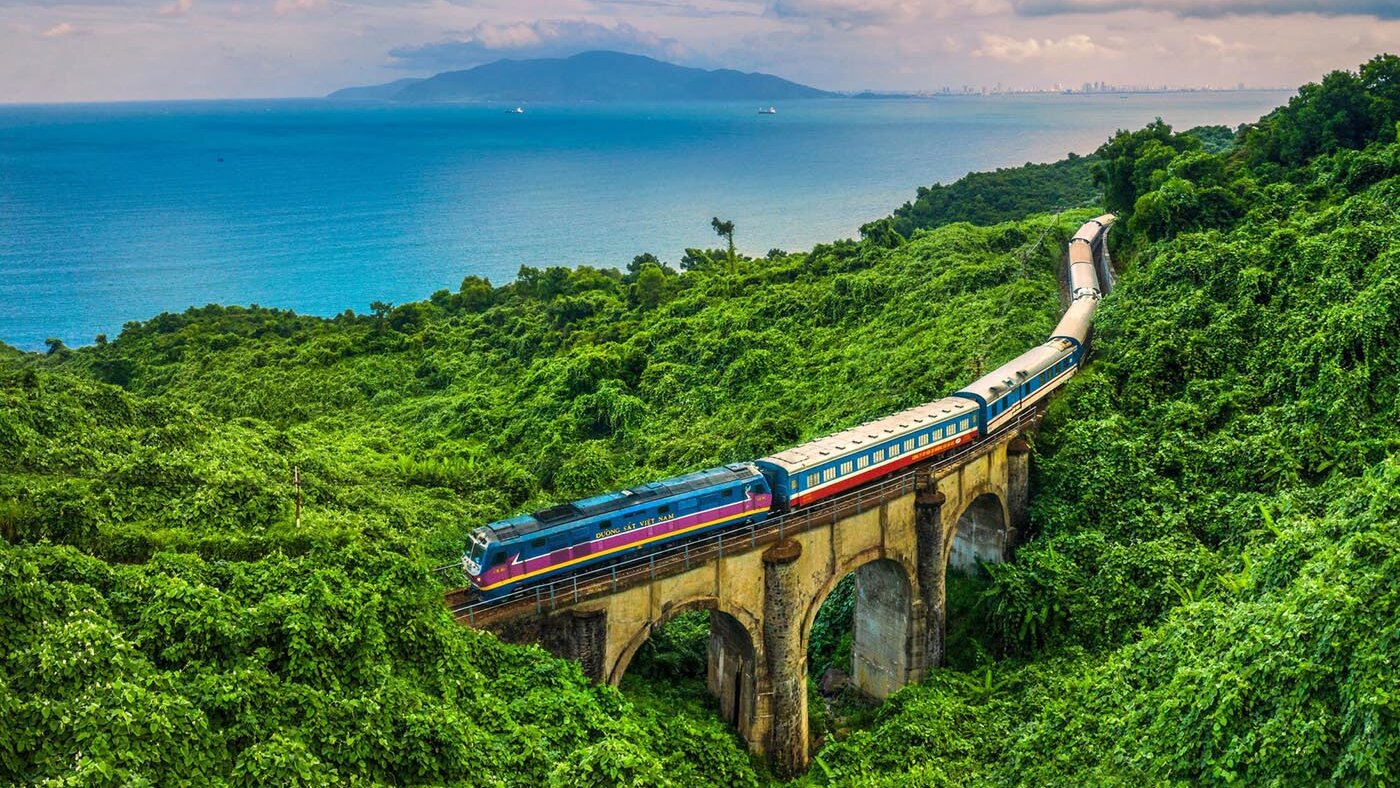Discover the Hidden Beauty of VIETNAM
Read moreEpic travel adventures that linger in your heart
Read more 8 May, 2025 0 Comment 375 Views
8 May, 2025 0 Comment 375 ViewsA Complete Travel Guide to Hai Van Pass Vietnam by Locals
Hai Van Pass Vietnam is not just a road, it’s a journey through history, culture, and breathtaking natural beauty. Known as one of the most scenic drives in Southeast Asia, this mountain pass offers a perfect blend of rugged coastline, lush green hills, and panoramic ocean views.
Located between Da Nang and Hue, the Hai Van Pass ("Ocean Cloud Pass") is a favorite for motorbike enthusiasts, road trip lovers, and anyone seeking a scenic detour from the typical highway. It’s more than just a way to get from A to B, it’s a destination in itself.
Whether you're an adventure seeker on two wheels, a couple looking for a romantic photo spot, or a history buff curious about Vietnam’s past, this guide will show you everything you need to know to make the most of your Hai Van Pass adventure.
1. Things You Should Know About Hai Van Pass Vietnam
1.1. What Is the Hai Van Pass?
Hai Van Pass (Vietnamese: Đèo Hải Vân), stretching over 21 kilometers along National Highway 1A, is a mountain road that winds up and over a spur of the Annamite Range. Its peak sits at about 496 meters above sea level, making it the highest coastal road in Vietnam. It offers breathtaking views over the East Sea, with the sprawling city of Da Nang on one side and the serene fishing villages of Lang Co on the other.
So what makes it so famous?
- It became globally recognized after being featured on the BBC’s Top Gear series, where the hosts called it “a deserted ribbon of perfection.”
- Every twist and turn reveals a new postcard-worthy view, whether it’s the coastline, the lush jungle, or the sparkling sea below.
- Once a military checkpoint and natural boundary between ancient kingdoms, the pass holds centuries of historical value.
Today, it's regarded as one of the best road trips in Asia and perhaps the most photogenic detour in Vietnam.

Hai Van Pass - "a deserted ribbon of perfection" 1.2. Where Is Hai Van Pass?
Location: The Hai Van Pass lies on the border of Da Nang City and Hue City, Vietnam. It connects Da Nang in the south with Hue in the north, tracing the spine of the coastal mountains.
Opening Hours: Open 24/7, but best driven during daylight from 6:00 AM to 5:00 PM.Navigation Tip: Use Google Maps offline mode or Maps.me - signal can be unreliable in remote areas.
Toll Fee (Tunnel only): 35,000 VND for cars, not applicable if taking the pass.How to Get There:
From Da Nang (20 km to the start of the pass):
- Motorbike: The most popular choice. Rentals are available from 120,000–200,000 VND/day. Head north via Highway QL1A.
- Private Car with Driver: Ideal for families or groups. Travel time is approximately 45 minutes.
- Guided Jeep or Motorbike Tours: Offers a stress-free ride with multiple scenic stops, commentary, and great photo opportunities.
- Train to Hue: For a more relaxed, scenic experience, take the Reunification Express train that curves around the pass cliffs.
From Hue (65 km):
- Motorbike or car ride south along QL1A, entering the pass from the opposite direction.
- Great option for travelers who plan to spend a day journeying from Hue to Da Nang or Hoi An.
Local Tips:
- Avoid using the Hai Van Tunnel if you want the scenic route, the tunnel bypasses the mountain and is restricted for motorbikes.
- The Hai Van Tunnel, completed in 2005, cuts through the mountain and is used by most trucks and cars. Motorbikes are not allowed inside the tunnel and must take the old pass, which is perfect, since it’s the scenic route.
1.3. What to Expect on the Drive
- Sharp turns and winding roads with limited guardrails, drive cautiously.
- Changing weather: you can go from sunny to misty within minutes.
- Several roadside stalls and cafés with epic views - ideal for breaks and photos.
- Wildlife: You might spot monkeys, birds, or butterflies flitting through the trees.
Tip: There are no gas stations on the pass itself, make sure to fill up in Da Nang or Hue before your journey.
1.4. Best Time to Visit Hai Van Pass Vietnam
The climate in central Vietnam is divided into two main seasons: the dry season (February to August) and the wet season (September to January). While the pass is technically accessible year-round, certain months are better suited for travel.
Dry Season (February to August) – Ideal for Scenic Travel
This period offers clear skies, minimal rain, and better visibility. Sunrise and sunset views are absolutely stunning on clear days. This season is perfect for combining your trip with nearby beaches like Lang Co or My Khe.
The months from March to May are particularly pleasant, with cooler temperatures, fewer tourists, and green landscapes.
Rainy Season (September to January) – Moody but Riskier
This is the time when you can expect frequent rain and fog. Visibility may be poor, and the road can become slippery, especially for motorbikes. However, some travelers still enjoy the mystical atmosphere of the pass during light mist.
Always check the weather forecast before your ride. Avoid traveling during stormy conditions, particularly in October and November.
Best Time of Day to Visit Hai Van Pass
- Early Morning (6:00–9:00 AM): Fewer vehicles, fresh air, and golden lighting over the mountains.
- Late Afternoon (3:00–5:30 PM): Soft lighting and cooler temperatures, ideal for capturing landscapes.
Driving the pass after dark is not recommended, there are no street lights, and the road can be difficult to navigate.
2. Top Things to Do and See Along Hai Van Pass Vietnam
While Hai Van Pass itself is a scenic masterpiece, what makes the journey truly memorable are the incredible stops and hidden gems that dot the winding road. Whether you’re on a motorbike adventure or a guided tour, exploring these sites adds a new layer of excitement to your Hai Van Pass experience.
2.1. Explore Hai Van Gate (Hai Van Quan) – The Historical Landmark at the Peak
Located at the highest point of the pass, Hai Van Gate (also known as “De Nhat Hung Quan” – the most grandiose frontier post) is a must-see historical site. Built in the 19th century under the Nguyen Dynasty, this stone structure once served as a military checkpoint between the ancient kingdoms of Champa and Dai Viet, and later during the French and American wars.
What You’ll See:
- Ancient stone gates engraved with calligraphy.
- Ruins of old French bunkers with rusted cannon remnants.
- Panoramic views of Da Nang Bay to the south and Lang Co Bay to the north.
Tip: Bring sturdy shoes if you want to explore the ruins around the area, as the terrain can be uneven. Morning visits are best to avoid heat and get clear views.
2.2. Take in the Stunning Coastal Views from Scenic Viewpoints
Hai Van Pass Vietnam is famed for its sweeping ocean views, and there are several natural viewpoints where you can stop to soak it all in. These rest stops are perfect for photos, drone footage, or just a breather with fresh sea air.
Best Viewpoints:
- Southbound Lookouts: Facing Da Nang Bay, perfect for sunrise views and glimpses of Son Tra Peninsula.
- Northbound Stops: Facing Lang Co Bay and the beautiful turquoise lagoon, stunning at sunset.
Photography Tips:
- Bring a polarizing filter to capture the contrast between the sky and ocean.
- Cloudy days can still yield dramatic shots with mist drifting over the hills.

Hai Van Pass Vietnam is famed for its sweeping ocean views 2.3. Discover War-Era Bunkers and Watchtowers
Scattered along the summit of Hai Van Pass are military relics from both the French colonial era and the Vietnam War. These overgrown bunkers and concrete watchtowers offer a raw, unfiltered look into Vietnam’s wartime history.
Why Visit:
- Great for history buffs and photographers.
- These bunkers offer lesser-known viewpoints with fewer tourists.
Safety Note: Watch your step when entering the ruins, as some structures are crumbling and without barriers.
2.4. Cool Off at Lang Co Beach and Lap An Lagoon
Once you cross to the northern side of the pass, Lang Co Beach awaits with soft golden sand and calm waters. It’s one of Vietnam’s lesser-known beach gems, making it perfect for a quiet swim or seafood lunch without the crowds.
Things to Do at Lang Co:
- Swim in the clean, calm sea.
- Walk along the long sandy shore for solitude.
- Dine at local seafood shacks serving grilled clams, steamed crab, and crispy squid.
Just nearby is Lap An Lagoon, a tranquil spot where the mountains reflect off still water. Stop by one of the floating seafood restaurants for a meal with a view.

Take a walk along Lang Co Beach to find peace and quiet 2.5. Try Authentic Vietnamese Coffee at Cliffside Cafes
Few things feel more refreshing than enjoying a cold cà phê sữa đá while overlooking the East Sea from a mountainside café. Hai Van Pass features several local-style coffee shops nestled in prime viewing spots.
Recommended Spots:
- Đỉnh Đèo Café: One of the highest points with a cozy seating area and strong coffee.
- Café Đá Mây (Cloud Rock Café): Hidden gem halfway up the pass with panoramic glass walls.
What to Try:
- Vietnamese drip coffee (hot or iced).
- Coconut coffee.
- Fresh sugarcane juice or herbal tea if you’re avoiding caffeine.
2.6. Enjoy the Ride – Especially by Motorbike
Of course, one of the best experiences is the ride itself. With every twist and turn, Hai Van Pass offers a thrilling road trip through jungle-clad hills, misty mountaintops, and coastal curves. The feeling of riding this pass is often compared to legendary routes like the Pacific Coast Highway in California or the Amalfi Coast in Italy.
Why Ride It:
- One of the best coastal roads in Southeast Asia.
- Perfect for GoPro filming or travel vlogs.
- The freedom to stop anywhere and take in the view.
Rental Tip: If you don’t want to return to your starting point, choose a one-way motorbike rental with luggage transfer between Hue and Da Nang - this is a popular choice among backpackers.
3. Travel Tips for a Safe and Enjoyable Hai Van Pass Journey
Traveling Hai Van Pass is one of the highlights of any trip to Central Vietnam, but like any mountain road, it requires a bit of preparation to ensure your adventure is smooth, safe, and unforgettable. Whether you're driving yourself or joining a tour, here are some essential travel tips to keep in mind:
3.1. Best Way to Experience Hai Van Pass
You have several options for exploring Hai Van Pass, each with its own advantages:
Motorbike Adventure:
- Ideal for backpackers and independent travelers.
- Rentals in Da Nang or Hue cost between 120,000–200,000 VND/day.
- One-way rentals with luggage transfer are available if traveling from Da Nang to Hue (or vice versa).
- Tip: If you’re not confident on a motorbike, choose a motorbike tour where you ride pillion (on the back) with an experienced driver.
Private Car with Driver:
- Great for families or groups.
- Offers flexibility, comfort, and stops for photos without the stress of navigating.
- Costs around $50–$70 for a one-way trip with photo stops.
Jeep Tour or Bus Tour with Guide:
- Adds a local guide’s perspective, plus extra safety.
- Tours often include visits to Lang Co Beach, Lap An Lagoon, and war relics.
- Jeep Tour is the most unique way with off-road trip and visit all highlights of Central Vietnam.
3.2. What to Bring and Wear
- Helmet – Required by law and essential for safety.
- Light Jacket – It can get surprisingly cool and windy at the summit.
- Sunscreen & Sunglasses – You’ll be in the sun most of the day.
- Water & Snacks – There are some cafés, but not in all areas.
- Camera/Phone Charger – The views are photogenic from every angle.
Clothing Tip: Wear comfortable clothes and closed shoes if you plan to explore ruins or viewpoints off the road.
3.3. Weather and Timing
Best Season:
- February to August – Clear skies, dry roads, and excellent visibility.
- Avoid September to December – Rainy season brings slippery roads and low visibility due to fog and storms.
Best Time of Day to Go:
- Morning (8:00 AM – 11:00 AM): Best lighting and less traffic.
- Late Afternoon (3:00 PM – 5:30 PM): Golden hour views and cooler temps.
Warning: Avoid driving the pass at night, especially if you’re not familiar with the road. There are limited lights, sharp curves, and the occasional truck or tour bus.

The best time to explore Hai Van Pass is from February to August 3.4. Safety Tips
- Drive cautiously, especially around blind corners.
- Avoid overtaking on curves or in foggy conditions.
- Don’t rely on Google Maps alone, ask locals if unsure of the route.
- Check your motorbike’s brakes and fuel before setting off.
3.5. Some Facts about Hai Van Pass Vietnam Road Trip You Have to Know
- The pass itself is about 21 kilometers long and takes 45 minutes to 1.5 hours to drive through, depending on stops and traffic.
- While the road is well-paved and not too steep, beginners should exercise caution. If you’re unsure, opt for a motorbike tour with a guide or ride pillion.
- You’ll find small cafés, souvenir shops, and scenic rest stops at the peak and along the way. Many offer clean restrooms and snacks.
- The road is free to access, and you can stop at most viewpoints without paying. Some cafés at scenic stops may ask for a small fee if you don’t order anything.
- You're highly recommended to have a day trip from Da Nang, Hue or Hoi An to Hai Van Pass. It’s definitely a perfect half-day trip. You can return the same day or combine it with other destinations like Lang Co Beach for a full-day itinerary.
Explore Da Nang City with Local Experts
For an unforgettable experience not only Hai Van Pass but also around Da Nang, we, as local experts, offer daily tours including both group and private options. Whether you prefer a shared adventure or a personalized experience, our tours ensure you enjoy all the best activities that Da Nang City offers.

Explore Linh Ung Pagoda with Venus Travel With over 5,000 five-star reviews, Venus Travel guarantees a well-organized, insightful, and enjoyable journey, led by professional guides who will make sure you experience the true essence of this stunning destination. Book your tour today and travel Vietnam in the most immersive way possible!
For authentic travel advice and tour planning by Vietnam local experts, feel free to contact us 24/7! Don’t forget to follow us for the latest updates on Vietnam travel news and local tips!
- Office 1: 14 An Nhon 10, Da Nang City, Vietnam
- Office 2: 429A Cua Dai St, Hoi An City, Viet Nam
- Email: venustravelvietnam@gmail.com
- Instagram/Youtube/Tiktok/Facebook: venustravel_vietnam
- Website: www.venusvietnamtravel.com
- Travelers' Choice in 2024 on Tripadvisor: https://www.tripadvisor.com.vn/Attraction_Review-g298082-d12261731-Reviews-Venus_Travel-Hoi_An_Quang_Nam_Province.html
- Top Rated on GetYourGuide: www.getyourguide.com/s/?q=supplier:87597
- Whatsapp/Zalo/Viber: (+84) 905 775 088 (English)/ (+84) 964 056 190 (Chinese)
0 0 votesGuide0 0 votesValue For Money0 0 votesOrganization0 0 votesServiceSubscribe0 FeedbackOldestNewest Most VotedInline FeedbacksView all commentsRecent Post
- Saigon Central Post Office: History, Highlights & Tips from Locals
- A Local Expert’s Guide for First-Timer to the Independence Palace
- All You Should Know Before Coming Saigon Notre-Dame Cathedral
- Things to Do in Da Nang on Your First Day (Best 1-Day Itinerary)
- Travel Da Nang in July: Weather, Things to Do & Tips from Locals
Tag
Related tours
Vietnam Signature 14 days trip
14 Days From $1012 / person 4.8(236)Marble Mountains – Hoi An Ancient Town Morning Tour (Private tour)
Half Day From $0 / person 4.8(236)Ha Noi – Halong Bay – Ninh Binh (Hoa Lu – Tam Coc)
5 Days From $0 / person 4.8(236)Halong Bay Full-Day Deluxe Trip
Full Day From $59 / person 4.8(236)Ho Chi Minh City Full-day Tour
Full Day From $43 / person 4.8(236)Same Category
All You Should Know Before Visiting Thien Hau Pagoda in Sai Gon
0 Comment 45 Views
Saigon Central Post Office: History, Highlights & Tips from Locals
0 Comment 62 Views
A Local Expert’s Guide for First-Timer to the Independence Palace
0 Comment 103 Views
All You Should Know Before Coming Saigon Notre-Dame Cathedral
0 Comment 76 Views
Things to Do in Da Nang on Your First Day (Best 1-Day Itinerary)
0 Comment 106 Views
Travel Da Nang in July: Weather, Things to Do & Tips from Locals
0 Comment 321 Views
